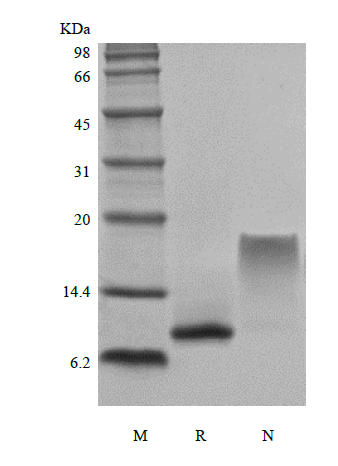- Synonyms
- CKB-8, MIP-3, MIPIF-1
- Source
- Escherichia coli.
- Molecular Weight
- Approximately 11.4 kDa, a single, non-glycosylated polypeptide chain containing 99 amino acids.
- AA Sequence
- RVTKDAETEF MMSKLPLENP VLLDRFHATS ADCCISYTPR SIPCSLLESY FETNSECSKP GVIFLTKKGR RFCANPSDKQ VQVCMRMLKL DTRIKTRKN
- Purity
- > 97 % by SDS-PAGE and HPLC analyses.
- Biological Activity
- Fully biologically active when compared to standard. The biological activity determined by a chemotaxis bioassay using human T-lymphocytes is in a concentration of 10-50 ng/ml.
- Physical Appearance
- Sterile Filtered White lyophilized (freeze-dried) powder.
- Formulation
- Lyophilized from a 0.2 μm filtered concentrated solution in 20 mM PB, pH 7.4, 150 mM NaCl.
- Endotoxin
- Less than 1 EU/μg of rHuMIP-3/CCL23 as determined by LAL method.
- Reconstitution
- We recommend that this vial be briefly centrifuged prior to opening to bring the contents to the bottom. Reconstitute in sterile distilled water or aqueous buffer containing 0.1 % BSA to a concentration of 0.1-1.0 mg/mL. Stock solutions should be apportioned into working aliquots and stored at ≤ -20 °C. Further dilutions should be made in appropriate buffered solutions.
- Stability & Storage
- Use a manual defrost freezer and avoid repeated freeze-thaw cycles.
- 12 months from date of receipt, -20 to -70 °C as supplied.
- 1 month, 2 to 8 °C under sterile conditions after reconstitution.
- 3 months, -20 to -70 °C under sterile conditions after reconstitution.
- Usage
- This material is offered by Shanghai PrimeGene Bio-Tech for research, laboratory or further evaluation purposes. NOT FOR HUMAN USE.
- SDS-PAGE

- Reference
- 1. Novak H, Muller A, Harrer N, et al. 2007. J Immunol, 178: 4335-41.
2. Votta BJ, White JR, Dodds RA, et al. 2000. J Cell Physiol, 183: 196-207.
3. Poposki JA, Uzzaman A, Nagarkar DR, et al. 2011. J Allergy Clin Immunol, 128: 73-81 e4.
- Background
- CCL23 is a member of CC chemokine family and is encoded by CCL23 gene located on Chr.17 in humans, where near several other CC chemokines. Highly expressed in adult lung, liver, skeletal muscle and pancreas, this protein shows strong chemotactic activity for monocytes, resting T-lymphocytes, and neutrophils, but not for activated lymphocytes. It elicits the effects by binding to CCR1. CCL23 is reported that it can be cleaved into four forms: CCL23 (19-99), CCL23 (22-99), CCL23 (27-99), CCL23 (30-99).









 COA Application
COA Application


